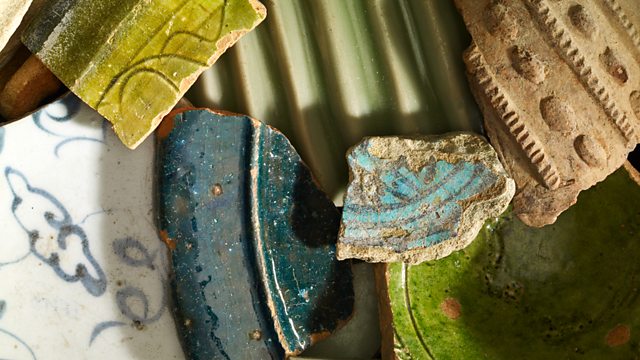Kilwa pot sherds
In a week that explores the tangle of trade routes that crisscrossed the globe 1000 years ago, Neil MacGregor sifts through broken pot fragments from an African beach.
This week Neil MacGregor has been looking at objects from Japan, Britain, Java and central Europe, exploring the great arcs of trade that connected Africa, Europe and Asia a thousand years ago. Today he sifts through a selection of broken pots, found on a beach in East Africa, to see what they might tell us. Smashed pottery, it seems, can be astonishingly durable and can offer powerful historical insights. These ceramic bits - in a variety of glazes and decorations - were found on the island of Kilwa Kisiwani off Tanzania. Neil uses the fragments to tell the story of a string of thriving communities along the East African coast with links across the Indian Ocean and beyond. The historian Bertram Mapunda and the writer Abdulrazak Gurnah describe the significance of these broken pieces and help piece together the great cross-cultural mix that produced the Swahili culture and language.
Producer: Anthony Denselow
Last on
More episodes
Next
You are at the last episode
![]()
A History of the World in 100 Objects - objects related to money, trade and travel.
About this object
Location: Kilwa Kisiwani, Tanzania
Culture: African Cultures
Period: 10th-14th century AD
Material: Ceramic
听
These broken pieces of pots were found on the shores of Kilwa Kiswani, an island off Tanzania, which was once home to a major medieval African port. The pale green porcelain pieces are from China, the dark green and blue pieces come from the Persian Gulf and the brown unglazed pieces were made in East Africa. This rubbish reveals a complex trade network that spread across the Indian Ocean, centuries before the European maritime empires of Spain, Portugal and Britain.
Who brought these pots to Kilwa?
From around AD 800 merchants from Africa, the Middle East, India, and later even China flocked to the East African ports of Kilwa and Mombasa, which quickly grew into wealthy cities. These merchants traded in pots, spices, ivory, gems, wood, metal and slaves. A new language, Swahili, developed in this multi-cultural environment, combining existing African languages with Arabic. Islam was adopted as the religion in these ports, perhaps to aid in trade relations with the Middle East and also to protect African merchants from being enslaved by other Muslims.
Did you know?
- Still spoken in East Africa, Swahili is the only language of African origin among the official languages of the African Union.
Pieces of a cosmopolitan past
By Dr Stephanie Wynne-Jones, archaeologist, University of Bristol
听
These sherds of imported ceramics found at Kilwa Kisiwani, Tanzania, represent a much larger corpus found across the sites of the Swahili coast. At Kilwa, they litter the beach and show up in the plough furrows of modern inhabitants, testifying to that town鈥檚 long and intensive involvement in Indian Ocean trade.
These sherds come from a range of sources: Sassanian-Islamic and Sgraffiato wares reflect a long-standing link with the Persian Gulf, blue-and-white porcelain and celadon relate to a later peak in Chinese trade in the Indian Ocean. Their existence at the Swahili towns of the East African coast allowed the first archaeological recognition of this rich trading society, and put into context the elaborate coral-built architecture and Islamic practice of the coast鈥檚 inhabitants.
Although initially seen as evidence of Arab settlers on the coast, the imports can now be viewed as part of a much larger assemblage which is dominated by locally-produced ceramics of a shared coastal tradition. This local pottery has firmly established the African roots of the coastal towns, as well as the extent of interaction and identification between them.
Imported wares at Swahili sites are - of course - an important index of interaction with the Indian Ocean world, and a guide to the changing priorities of the monsoon traders. Archaeologies of the coastal towns have illustrated a shifting focus from the Persian Gulf between the seventh and tenth centuries AD, to the Red Sea from the eleventh century; substantial quantities of Chinese goods were incorporated from the fourteenth century onwards. The imports are also often our main guide to the dating of Swahili sites in the absence of absolute dates, as they originate in regions with well-established chronological sequences.
Recent archaeologies of the East African coast have moved towards analysis of the social context of imports. They clearly had a special role in Swahili society, and were displayed prominently in mosques, tombs and houses. By the fourteenth and fifteenth century, it was common practice for imported bowls to be cemented into the vaults and mihrabs of coastal mosques. Swahili houses often contained specially-designed wall niches and spaces for display of these objects. It is also notable that during the eleventh century we see a shift in the imported assemblage, from large jars to bowl forms. This suggests that the ceramics had become objects of trade in their own right, rather than travelling simply as containers for other goods.
Clearly, the ancient Swahili were as aware as we are today of the power of these objects to display and reference their cosmopolitan society and its links with a wider Indian Ocean world.
Transcript
Broadcasts
- Fri 25 Jun 2010 09:45成人快手 Radio 4 FM
- Fri 25 Jun 2010 19:45成人快手 Radio 4
- Sat 26 Jun 2010 00:30成人快手 Radio 4
- Fri 25 Jun 2021 13:45成人快手 Radio 4
Featured in...
![]()
Money, Trade and Travel—A History of the World in 100 Objects
A History of the World in 100 Objects - objects related to money, trade and travel.
Podcast
-
![]()
A History of the World in 100 Objects
Director of the British Museum, Neil MacGregor, retells humanity's history through objects





